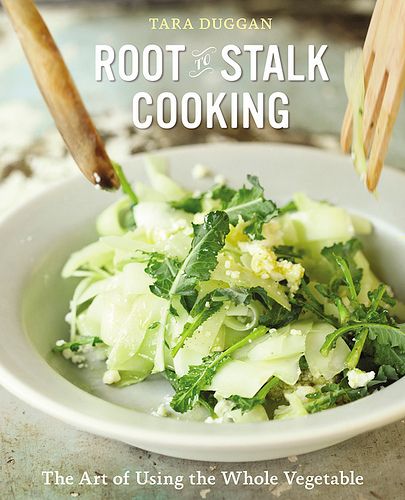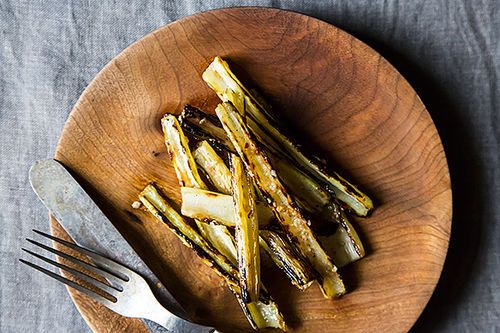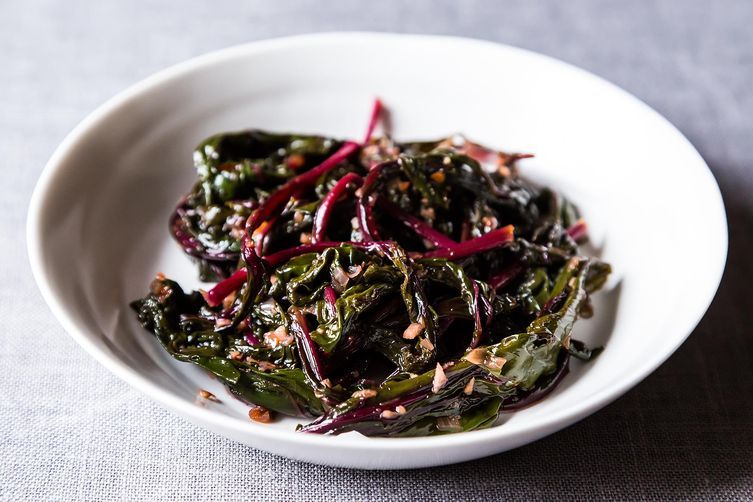Popular on Food52
Continue After Advertisement
37 Comments
Carol
March 30, 2016
I use radish tops in salads. I also make and freeze pesto a la Carol by using any green leafed vegetable in garden such as basil, swiss chard, winter kale.
AntoniaJames
September 23, 2013
Circling back here to this conversation: I just made the roasted apple butter recipe posted here last week: http://food52.com/recipes/23998-roasted-apple-butter#comments
It turned out beautifully, as noted in more detail in the comments there. I simply could not throw away just yet the "spent" peels and small bits clinging to them in the mill, so I scraped them out into a medium saucepan and poured a quart of filtered water over them. I brought it to a boil, gave it a nice brisk stir, and let it sit for an hour; then I strained it. I'll reduce that fragrant light syrup down to about a pint, to use in hot (bourbon!) toddies, come winter. ;o)
It turned out beautifully, as noted in more detail in the comments there. I simply could not throw away just yet the "spent" peels and small bits clinging to them in the mill, so I scraped them out into a medium saucepan and poured a quart of filtered water over them. I brought it to a boil, gave it a nice brisk stir, and let it sit for an hour; then I strained it. I'll reduce that fragrant light syrup down to about a pint, to use in hot (bourbon!) toddies, come winter. ;o)
cookinginvictoria
September 13, 2013
Like so many others here, I make stock from vegetable scraps. I also use shrimp shells to make a very flavorable fish stock. When they are in season, spotted prawn shells make a fabulous stock, perfect for making risotto.
I will second antoniajames's comments below about using corn cobs, husks, and silks to make corn stock. So versatile and so good!
Lastly, one of my favorite root-to-stalk cooking recipes comes from Lidia Bastianich (Lidia's Family Table), and it's simply titled A Smooth Sauce from a Couple of Tough Vegetables. You take asparagus stubs and the top and outer layers of leeks and boil them gently in water with garlic, onion, olive oil, salt and pepper. After all is soft and water has evaporated down, puree the vegetables, strain through a sieve, thin with boiling pasta water and serve with your favorite pasta. Truly delicious -- and very simple to prepare!
I think that this would be a great theme for a future food52 recipe contest: Your Best Root to Stalk Recipe! :)
I will second antoniajames's comments below about using corn cobs, husks, and silks to make corn stock. So versatile and so good!
Lastly, one of my favorite root-to-stalk cooking recipes comes from Lidia Bastianich (Lidia's Family Table), and it's simply titled A Smooth Sauce from a Couple of Tough Vegetables. You take asparagus stubs and the top and outer layers of leeks and boil them gently in water with garlic, onion, olive oil, salt and pepper. After all is soft and water has evaporated down, puree the vegetables, strain through a sieve, thin with boiling pasta water and serve with your favorite pasta. Truly delicious -- and very simple to prepare!
I think that this would be a great theme for a future food52 recipe contest: Your Best Root to Stalk Recipe! :)
Emma W.
September 12, 2013
Broccoli stems have such beautiful and delicious (and always wasted) leaves
Hannah
September 11, 2013
I definitely prefer broccoli stalks to the "trees" for cooking or eating raw. We end up giving a lot of veggie scraps to our dogs, who go nuts for carrot peel.
Panfusine
September 11, 2013
One of my favorite chutneys is from a recipe handed down from my great grandmother. It uses the central thready part (that surrounds the seeds) of pumpkins & squashes, toasted along with Urad dal,tuvar dal, mustard, coconut & tamarind, and then blended to a paste. Another favorite at home is a relish made from the center of cauliflower & broccoli stalks.
Tiberia
September 11, 2013
Most green leafy scraps go to my house rabbits, Emmett Lee and Beatrix. And we compost. Alot. Does freezing overripe bananas for future baking projects count?
SallyM
September 11, 2013
I use every part of the vegetable that I can for a weekly pot of v egetable soup. What I can't use goes into the compost bin to restart the process...
gabsimonelouise
September 11, 2013
Thai curries and other Thai recipes are a great way to use all parts of a cilantro plant...roots, stems, leaves, and seeds!
jubu28
September 11, 2013
I save onion peels for stock. Also you can grate the broccoli stems and add to slaw
kkimberly
September 11, 2013
I freeze leftover herbs into ice cubes for lovely minty water in the summer or for sauces. And all peelings are boiled up for the chickens of course.
Penny D.
September 11, 2013
I have a pickey eater who hates veggies but is a voracious meateater all stocks and stems are used to thicken gravy...no cornstarch or flour needed...the best part, he has no idea!
ieatthepeach
September 11, 2013
Like a lot of people here, I keep a stock bag in the freezer for scraps. I also like to pickle chard stems (so tasty!) and I always save the greens from radishes to toss into stir-fries or pasta sauces.
And, of course, broccoli stems--they're the best part of broccoli, as far as I'm concerned. I just gnaw on them while I'm preparing the rest of the broccoli.
And, of course, broccoli stems--they're the best part of broccoli, as far as I'm concerned. I just gnaw on them while I'm preparing the rest of the broccoli.
KRae
September 11, 2013
I use herb stems to make pestos or bundle them with onion and garlic scraps into pots of beans. Also, this weekend I made basil ice cream and steeped the stems in the custard rather than using (and discarding) the delicious leaves.
Sandra
September 10, 2013
I pickle watermelon rinds, candy citrus peels, add carrot and apple pulp ( from juicing) into quick breads, and toast pumpkin seeds. I love the wonderful ideas for using corn husks!
Margit V.
September 10, 2013
I do use broccoli leaves and stems--the plants in my garden produce a generous number of scrumptious leaves during the growing season. With scraps, I use as much as possible in making veggie stock. The parts that are damaged or otherwise unsalvageable go into making compost. I love soup, so very little ever ends up as compost.
creamtea
September 10, 2013
I freeze the dark-green tops of leeks after washing and throw them into simmering chicken stock. I actually do like the broth from simmered artichokes. I simmer the artichokes with lots of garlic and minced parsley and some salt. They've been previously rubbed well with the cut side of a lemon. There are sometimes whole peppercorns added to the simmering water. I think I sometimes pour in a little good olive oil too. It may be just me, but I like slurping this broth up after the artichokes are consumed...





See what other Food52 readers are saying.